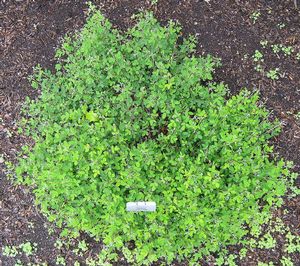View All Plants :: View All SUN PERENNIALS
Lespedeza bicolor 'Yakushima'
Shrub Bush Clover
Plant Type:
SUN PERENNIALSLespedeza bicolor ‘Yakushima’ – Hefty. A dwarf growing Shrub Bush Clover. Rosy purple pea florets on innumerable racemes stud the foliage for weeks on end in summer. The soft looking alternate trifoliate leaves are clean green all season and sometimes turn yellow to gold in autumn, sometimes not. In the north ‘Yakushima’ usually dies to the crown; but not to worry, it recovers with vigor when temperatures warm. And as ‘Yakushima’ blooms on new wood it will provide an amazing summer show annually. Farther south it will behave as a subshrub and sprout from old wood. Cutting grown.
Height:
12 inSpread:
30 inColors:
Rose PurpleCharacteristics and Attributes for Lespedeza bicolor 'Yakushima'
Season of Interest (Flowering)
- Spring / Summer / into Autumn
Season of Interest (Foliage)
- Spring / Summer / into Autumn
Nature Attraction
- Honey Bees & Native Bees
Light
- Full Sun
- Mostly Sunny
Attributes
- Foundation
- Border
- Hedgerow
- Rock Garden
- Drought Tolerant
- Labyrinth
- Edging
- Accent
- Shrub Border
- Ground Cover
- Hedge
- Massing
Growth Rate in the Garden
- Medium
Soil
- Draining
- Fertile
Origins
- Garden Origin
Propagated By
- Cutting Grown
Genus Overview: Lespedeza
Common Name: Shrub Bush Clover
We have great affection for the Bush Clovers. A soft looking shrub cloaked in clean blue green trifoliate leaves on stems that gracefully arch; vase-shaped earlier in the season the tendency for the semi-woody stems is to gently weep as the season progresses. They bloom on new wood during late season with amazing displays of pea flowers. We treat Bush Clover as an herbaceous perennial in the north, cutting it down to 2” stubs at the end of winter before new growth emerges. They are fantastic with Miscanthus, perennial sunflowers, Joe-pye weeds, butterfly bushes, ironweeds, asters and just plain beguiling with late blooming daylilies – oh, heck: they look great with anything and everything that blooms in the late season garden. Site them in full to nearly full sun planted in fertile draining soil where they will gradually increase their girth with each new annual flush of growth. All of the following offerings are cutting grown.
